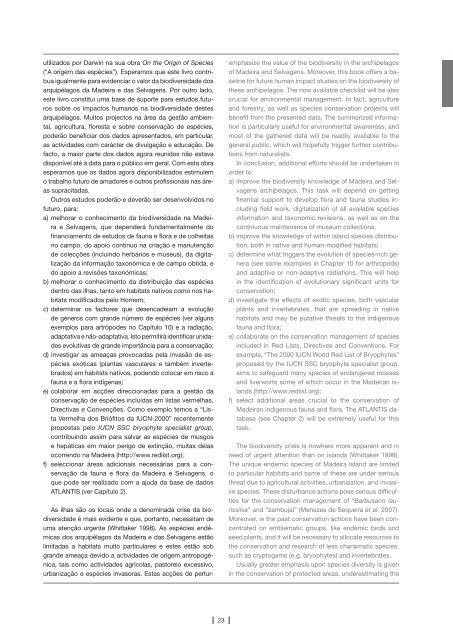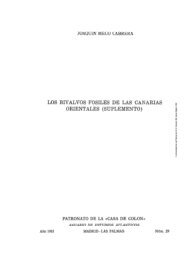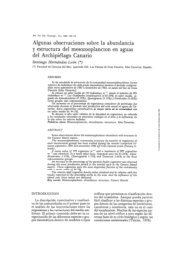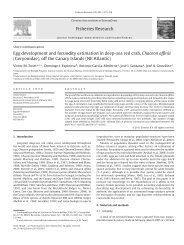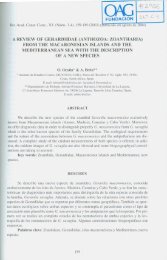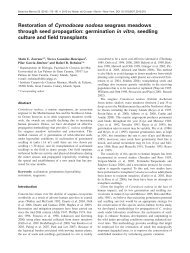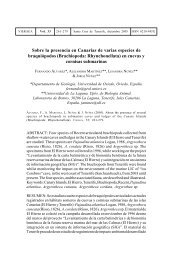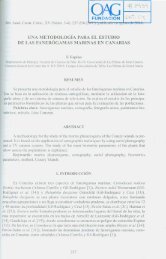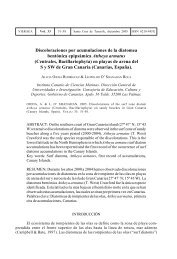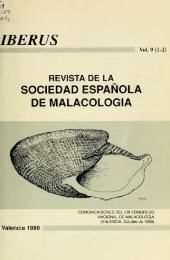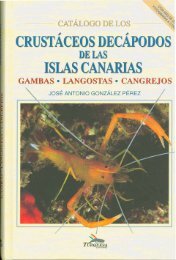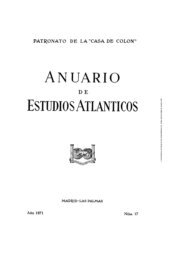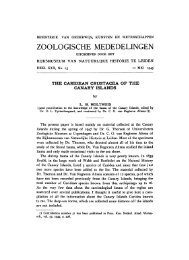of the madeira and selvagens archipelagos - redmic
of the madeira and selvagens archipelagos - redmic
of the madeira and selvagens archipelagos - redmic
Create successful ePaper yourself
Turn your PDF publications into a flip-book with our unique Google optimized e-Paper software.
utilizados por Darwin na sua obra On <strong>the</strong> Origin <strong>of</strong> Species<br />
(“A origem das espécies”). Esperamos que este livro contribua<br />
igualmente para evidenciar o valor da biodiversidade dos<br />
arquipélagos da Madeira e das Selvagens. Por outro lado,<br />
este livro constitui uma base de suporte para estudos futuros<br />
sobre os impactos humanos na biodiversidade destes<br />
arquipélagos. Muitos projectos na área da gestão ambiental,<br />
agricultura, floresta e sobre conservação de espécies,<br />
poderão beneficiar dos dados apresentados, em particular,<br />
as actividades com carácter de divulgação e educação. De<br />
facto, a maior parte dos dados agora reunidos não estava<br />
disponível até à data para o público em geral. Com esta obra<br />
esperamos que os dados agora disponibilizados estimulem<br />
o trabalho futuro de amadores e outros pr<strong>of</strong>issionais nas áreas<br />
supracitadas.<br />
Outros estudos poderão e deverão ser desenvolvidos no<br />
futuro, para:<br />
a) melhorar o conhecimento da biodiversidade na Madeira<br />
e Selvagens, que dependerá fundamentalmente do<br />
financiamento de estudos de fauna e flora e de colheitas<br />
no campo, do apoio contínuo na criação e manutenção<br />
de colecções (incluindo herbários e museus), da digitalização<br />
da informação taxonómica e de campo obtida, e<br />
do apoio a revisões taxonómicas;<br />
b) melhorar o conhecimento da distribuição das espécies<br />
dentro das ilhas, tanto em habitats nativos como nos habitats<br />
modificados pelo Homem;<br />
c) determinar os factores que desencadeiam a evolução<br />
de géneros com gr<strong>and</strong>e número de espécies (ver alguns<br />
exemplos para artrópodes no Capítulo 10) e a radiação,<br />
adaptativa e não -adaptativa. Isto permitirá identificar unidades<br />
evolutivas de gr<strong>and</strong>e importância para a conservação;<br />
d) investigar as ameaças provocadas pela invasão de espécies<br />
exóticas (plantas vasculares e também invertebrados)<br />
em habitats nativos, podendo colocar em risco a<br />
fauna e a flora indígenas;<br />
e) colaborar em acções direccionadas para a gestão da<br />
conservação de espécies incluídas em listas vermelhas,<br />
Directivas e Convenções. Como exemplo temos a “Lista<br />
Vermelha dos Briófitos da IUCN -2000” recentemente<br />
propostas pelo IUCN SSC bryophyte specialist group,<br />
contribuindo assim para salvar as espécies de musgos<br />
e hepáticas em maior perigo de extinção, muitas delas<br />
ocorrendo na Madeira (http://www.redlist.org);<br />
f) seleccionar áreas adicionais necessárias para a conservação<br />
da fauna e flora da Madeira e Selvagens, o<br />
que pode ser realizado com a ajuda da base de dados<br />
ATLANTIS (ver Capítulo 2).<br />
As ilhas são os locais onde a denominada crise da biodiversidade<br />
é mais evidente e que, portanto, necessitam de<br />
uma atenção urgente (Whittaker 1998). As espécies endémicas<br />
dos arquipélagos da Madeira e das Selvagens estão<br />
limitadas a habitats muito particulares e estes estão sob<br />
gr<strong>and</strong>e ameaça devido a actividades de origem antropogénica,<br />
tais como actividades agrícolas, pastoreio excessivo,<br />
urbanização e espécies invasoras. Estas acções de pertur-<br />
23<br />
emphasize <strong>the</strong> value <strong>of</strong> <strong>the</strong> biodiversity in <strong>the</strong> <strong>archipelagos</strong><br />
<strong>of</strong> Madeira <strong>and</strong> Selvagens. Moreover, this book <strong>of</strong>fers a baseline<br />
for future human impact studies on <strong>the</strong> biodiversity <strong>of</strong><br />
<strong>the</strong>se <strong>archipelagos</strong>. The now available checklist will be also<br />
crucial for environmental management. In fact, agriculture<br />
<strong>and</strong> forestry, as well as species conservation projects will<br />
benefit from <strong>the</strong> presented data. The summarized information<br />
is particularly useful for environmental awareness, <strong>and</strong><br />
most <strong>of</strong> <strong>the</strong> ga<strong>the</strong>red data will be readily available to <strong>the</strong><br />
general public, which will hopefully trigger fur<strong>the</strong>r contributions<br />
from naturalists.<br />
In conclusion, additional efforts should be undertaken in<br />
order to:<br />
a) improve <strong>the</strong> biodiversity knowledge <strong>of</strong> Madeira <strong>and</strong> Selvagens<br />
<strong>archipelagos</strong>. This task will depend on getting<br />
finantial support to develop flora <strong>and</strong> fauna studies including<br />
field work, digitalization <strong>of</strong> all available species<br />
information <strong>and</strong> taxonomic revisions, as well as on <strong>the</strong><br />
continuous maintenance <strong>of</strong> museum collections;<br />
b) improve <strong>the</strong> knowledge <strong>of</strong> within isl<strong>and</strong> species distribution,<br />
both in native <strong>and</strong> human -modified habitats;<br />
c) determine what triggers <strong>the</strong> evolution <strong>of</strong> species -rich genera<br />
(see some examples in Chapter 10 for arthropods)<br />
<strong>and</strong> adaptive or non -adaptive radiations. This will help<br />
in <strong>the</strong> identification <strong>of</strong> evolutionary significant units for<br />
conservation;<br />
d) investigate <strong>the</strong> effects <strong>of</strong> exotic species, both vascular<br />
plants <strong>and</strong> invertebrates, that are spreading in native<br />
habitats <strong>and</strong> may be putative threats to <strong>the</strong> indigenous<br />
fauna <strong>and</strong> flora;<br />
e) collaborate on <strong>the</strong> conservation management <strong>of</strong> species<br />
included in Red Lists, Directives <strong>and</strong> Conventions. For<br />
example, “The 2000 IUCN World Red List <strong>of</strong> Bryophytes”<br />
proposed by <strong>the</strong> IUCN SSC bryophyte specialist group,<br />
aims to safeguard many species <strong>of</strong> endangered mosses<br />
<strong>and</strong> liverworts some <strong>of</strong> which occur in <strong>the</strong> Madeiran isl<strong>and</strong>s<br />
(http://www.redlist.org);<br />
f) select additional areas crucial to <strong>the</strong> conservation <strong>of</strong><br />
Madeiran indigenous fauna <strong>and</strong> flora. The ATLANTIS database<br />
(see Chapter 2) will be extremely useful for this<br />
task.<br />
The biodiversity crisis is nowhere more apparent <strong>and</strong> in<br />
need <strong>of</strong> urgent attention than on isl<strong>and</strong>s (Whittaker 1998).<br />
The unique endemic species <strong>of</strong> Madeira Isl<strong>and</strong> are limited<br />
to particular habitats <strong>and</strong> some <strong>of</strong> <strong>the</strong>se are under serious<br />
threat due to agricultural activities, urbanization, <strong>and</strong> invasive<br />
species. These disturbance actions pose serious difficulties<br />
for <strong>the</strong> conservation management <strong>of</strong> “Barbusano laurissilva”<br />
<strong>and</strong> “zambujal” (Menezes de Sequeira et al. 2007).<br />
Moreover, in <strong>the</strong> past conservation actions have been concentrated<br />
on emblematic groups, like endemic birds <strong>and</strong><br />
seed plants, <strong>and</strong> it will be necessary to allocate resources to<br />
<strong>the</strong> conservation <strong>and</strong> research <strong>of</strong> less charismatic species,<br />
such as cryptogams (e.g. bryophytes) <strong>and</strong> invertebrates.<br />
Usually greater emphasis upon species diversity is given<br />
in <strong>the</strong> conservation <strong>of</strong> protected areas, underestimating <strong>the</strong>


